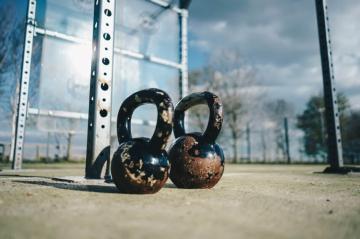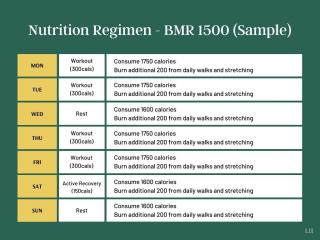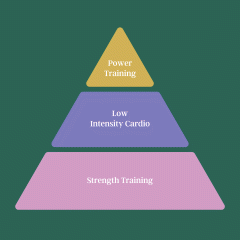My daughter is always on the go. She’s not one of those children who sit still for hours musing over a toy or a book. Nope. She’s much more likely to be jumping off the sofa like some kind of WWE wrestler or running back and forth, pushing herself off the walls—also like some kind of WWE wrestler. So, instead of trying to force her to sit still and learn her letters, I try to use activities for people with kinesthetic learning styles to make learning better suited for her current developmental stage.
The 4 Learning Styles
You’ve probably heard about learning styles by now. Maybe someone claimed that they were a visual learner, or a teacher dubbed you an auditory learner. Learning styles began in the 1990s when New Zealander Neil Fleming created a questionnaire to assess how people preferred to learn new information. This questionnaire is known as the VARK and is still used to determine people’s learning styles today.
There are four main learning styles according to Fleming’s VARK questionnaire:
Visual – Visual learners like to see new information. They prefer charts, graphs, and films over reading or hearing information—think images over sounds, movements, or written words. Auditory or Aural – Auditory learners prefer to hear new information. They tend to be drawn to audiobooks and music. Reading/Writing – Reading/writing learners prefer to do exactly that—read and write. They focus well when reading new information and readily process information by taking notes. Kinesthetic – Kinesthetic learners are drawn to movement. They tend to be out of their seats figuring out new information spatially and physically.Problem With Fleming’s Learning Styles
Because we’ve had nearly thirty years to study the efficacy of Fleming’s learning styles, we now know that learning styles are only a preference. Using your preferred learning style does not actually improve learning outcomes. That means if you prefer visual inputs, charts and graphs may be more comfortable for you, but using them doesn’t help you learn more.
A better way to think about learning styles is as learning preferences, but if you want to boost your learning, you should focus more on matching the learning style with the task at hand.
For example, I struggle with auditory information. When someone spells something aloud, I have a tough time processing what they’re spelling. However, I’ve had success with auditory input when I’m memorizing lines for a play or learning the lyrics of a song. Instead of saying that I’m a reading/writing learner or a visual learner, I know that my learning style depends on what it is I’m trying to learn.
What Are Kinesthetic Learning Styles?
Kinesthetic learning is embodied, active, and tactile. Instead of listening to a lecture or reading a book, the kinesthetic learning style involves moving through space. Even if you consider yourself more of a visual, auditory, or reading/writing learner, kinesthetic learning techniques can help you energize and memorize new information.
1. Energize
Kinesthetic learning techniques are a great way to wake up and get the blood pumping, which can help you study longer. If you find yourself yawning or falling asleep, you may want to stand up and move or get creative more with your learning strategies.
2. Memorize
Kinesthetic learning techniques are also a great way to unconsciously memorize new information. Procedural memory is when your body knows how to do something without you having to think consciously about it.
Think about riding a bike. If you had to think about every complicated step involved in bike riding, you’d crash every time you even attempted it. But procedural memory allows your body to just do it.
You can use your procedural memory to expand the amount of information you learn. When you get new information “in the body,” you’re really recording it as procedural memory, and you can memorize way more unconsciously than you can consciously.
Get the Most Out of Kinesthetic Learning Styles
Let’s say I’ve convinced you to try kinesthetic learning techniques. Besides just standing up and moving through space, here’s a more specific list of ways you can get the most of kinesthetic learning styles:
1. Get Up
The first and simplest way to get kinesthetic is to stand up. That’s right—get out of your chair. Get a standing desk or take a walk while you think something over. Since a kinesthetic learning style has to do with movement, the first step is to stand up and get moving.
2. Move Through Space
The next trick for kinesthetic learning styles is to move. Walk around while you memorize, process new information, or try to solve problems.
I like to pace when I’m on a phone call or walk the dog when I’m having some writer’s block. This helps get the blood pumping and helps keep me alert and creative.
3. Make It Tactile
Another way to make learning kinesthetic is to make it tactile. Incorporate objects that you can move around. Use index cards hung around the room to develop a plot or an essay. Make a model of the solar system instead of just reading about it. Create a physical flashcard deck to memorize new things instead of learning them on the computer or from a book.
The more you can cut, paste, shape, bend, fold, and manipulate, the better.
4. Place Things Places
One way that I tried to accommodate my daughter’s current kinesthetic learning style is by placing letters around the room. I then asked her to stand in the middle of the room and run to a certain letter. This approach was successful for a few reasons.
First, by making learning a game—or “gamifying”—I was making it fun and competitive, which kept my daughter engaged for longer.
Second, by making letter-learning active, I was able to keep my daughter’s energy up, which kept the blood and oxygen pumping to her brain. This stimulates learning.
Finally, by placing letters around the room, my daughter was associating letters spatially. This helps make learning more concrete and less abstract. The A is in the kitchen, and the B is in the dining room, instead of just being letters on a page. This helps give her another way to distinguish the letters. Just make sure to switch it up, so you’re not always associating one concept with one place.
This concept is also a great way to learn a new language. Put Post-It notes with your target language vocabulary all over the house. Put the word “mirror” on your mirror and the word “window” on your window.
This helps you learn throughout the day, but it also helps you associate the new word with the concept itself. When you look in the mirror, you are learning the new word for mirror. That’s context. It’s much easier to learn with context than by reading the new vocabulary word over and over.
I’ve also used this technique when I taught the areas of the stage. I drew a large grid on the floor and would yell out a stage direction—stage left or stage right or downstage center—then the class would have to run to that square on the grid as fast as they could. Because stage directions are already spatial, this kind of kinesthetic learning matches the learning task.
This technique could be effective for learning planets or geography. Get creative and place things places to make learning an embodied, spatial experience.
5. Combine Movements With Ideas
Another way to make learning kinesthetic is to combine movements with ideas. Trying to learn historical dates? Combine them with specific movements—mime rowing when you say 1492, Mime a guillotine when you yell 1789, or a falling wall for 1989. You get the idea.
By combining a movement with a concept, fact, or idea, you are increasing the likelihood that you’ll initiate your procedural memory and store that new knowledge in long-term memory.
6. Walking While You Work
You can also walk while you work. I’ve seen people work while on a treadmill and walk with a friend as they map out the structure for a new project. Walking is a great way to get unstuck. If you’re getting tired or bored or frustrated, get up, get out, and take a walk as you continue to learn, process, and create.
7. Exercise While You Learn
I’m also a big fan of exercising while you learn. In grad school, I would carve out time at the gym almost every day. This wasn’t a way to avoid my schoolwork. It was actually a time when learning came more easily.
Something about running on the treadmill or stepping on that elliptical machine distracted me enough to lower my stress and anxiety. I always found learning much less effortful when I was incorporating exercise. So, get to the gym and pump some iron while you memorize, quiz yourself, and study yourself smart.
Final Thoughts
You may not consider yourself a kinesthetic learner. I know I don’t. But that doesn’t mean kinesthetic learning techniques can’t help you learn better.
Moving through space and manipulating objects are great ways to get more parts of your brain involved in the learning process. So, get out of that desk chair and get moving to make kinesthetic learning work for you.
More About Learning Styles
Featured photo credit: Tyler Nix via unsplash.com





























































